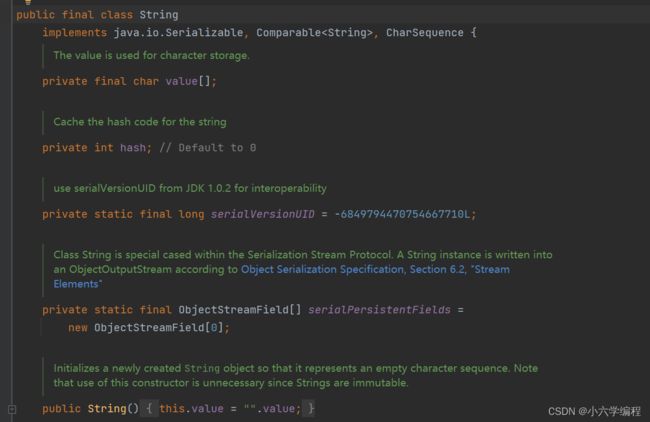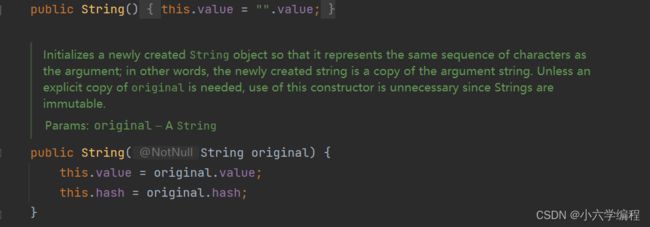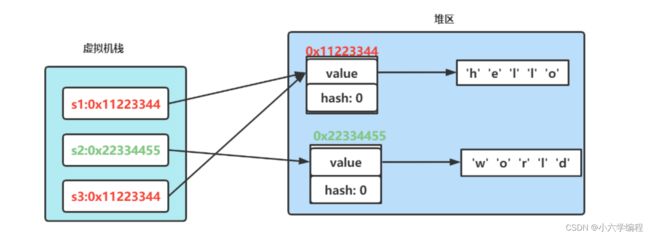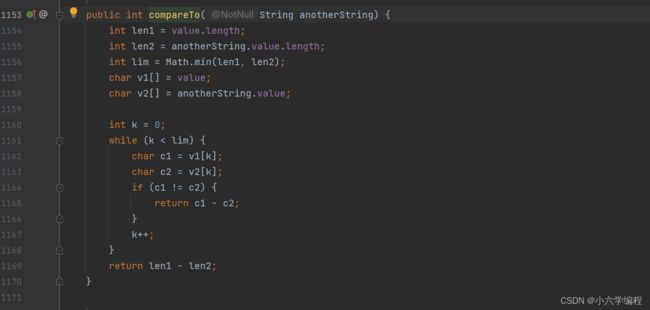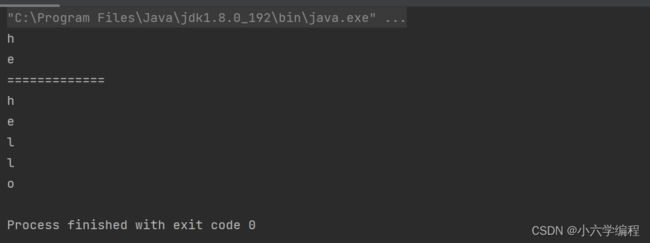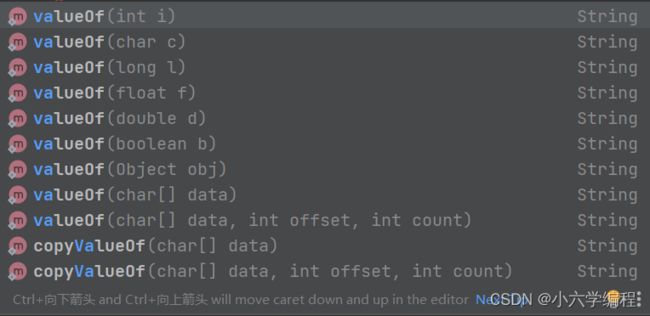String类型详解(上),Java中String有多强大你真的了解吗?
目录
一,什么是String类型?
二,常用构造方式
三,常用方法
1.String对象的长度
2.String对象的比较
2.1 equals
2.2compareTo
3.查找字符串
3.1. charAt
3.2 indexOf
3.3 indexOf(String str)
3.4 indexOf(String str,int fromIdex)
3.5 lastIdexOf(int ch)
编辑
3.6 lastIdexOf(int ch,int fromIdex)
编辑
3.7 int lastIndexOf(String str)
3.8 int lastIndexOf(String str,int fromIdexOf)
4,转化
4.1.数字转字符串
4.2.字符串转数字:
4.3.大小写转化
4.4.字符串转数组
5,格式化
6.字符串替换
6.1 直接将旧的替换为新的
6.2 CharSequence
6.3 replaceAll
6.4 replaceFirst
7.字符串的拆分
8.字符串的截取
9.其它操作方法
trim
一,什么是String类型?
在使用编程语言处理问题时往往会遇到与字符串相关的问题,当如果我们想定义一个字符串类型,这在C语言中其实是不存在的,得使用char*p来表示我们想要表达的字符串,但这其实是一个char*类型的指针。
而在Java当中存在一个全新的数据类型——String类型:它可以直接定义我们想要表示的字符串。
在IDEA上我们可以查看String的源码:
(这里只截取了一部分)
观察发现,这其实是一个类,而对类的学习,我们一定要从从它的构造方法开始学习。
通过构造方法发现它有无参的构造,有有参的构造,有参可以传的类型也有很多,下面将介绍常用的几个。
二,常用构造方式
字符串构造:
String类提供的构造方式有很多,常用的就以下三种
public static void main(String[] args) {
// 使用常量串构造
String s1 = "hello bit";
System.out.println(s1);
// 直接newString对象
String s2 = new String("hello bit");
System.out.println(s1);
// 使用字符数组进行构造
char[] array = {'h','e','l','l','o','b','i','t'};
String s3 = new String(array);
System.out.println(s1);
}
其他方法需要用到时,大家参考Java在线文档:Overview (Java Platform SE 8 ) (oracle.com)
public static void main(String[] args) {
// s1和s2引用的是不同对象 s1和s3引用的是同一对象
String s1 = new String("hello");
String s2 = new String("world");
String s3 = s1;
System.out.println(
System.out.println(
}
// 打印"hello"字符串(String对象)的长度
System.out.println("hello".length());
三,常用方法
String既然作为一个类,那么它一定包含了许多方法
1.String对象的长度
同数组一样,String引用的对象可以通过.length()来直接求得长度:
public class Main {
public static void main(String[] args) {
String str1 = "hello";
String str2 = "你好!";
int[] arr = {1,2,3,4,5};
System.out.println("str2 " + str1.length());
System.out.println("str2 " + str2.length());
System.out.println("arr " + arr.length);
}
}运行结果:
注意:
数组使用的是.length,而字符串是.length()方法。
另一个与长度有关的是.isEmpty()
当其String所引用的字符串长度为0时isEmpty()就会返回为true的布尔类型
public class Main {
public static void main(String[] args) {
String str = "";
System.out.println(str.length());
System.out.println(str.isEmpty());
}
}运行结果:
注意:
当String引用的对象为null时代表该引用不指向任何对象,并不代表该引用长度就为0,所以以下案例运行就会发生错误。
public class Main {
public static void main(String[] args) {
String str = null;
System.out.println(str.length());
System.out.println(str.isEmpty());
}
}2.String对象的比较
2.1 equals
public class Main {
public static void main(String[] args) {
String str1 = "hello";
String str2 = "hello";
System.out.println(str1 == str2);
}
}可以看到,字符串并不能使用“==”直接来判断是否相等。这是因为String和数组类似,并不是直接存储的对象的值,而是在栈区中开辟内存,存储堆区中该对象的地址。所以“==”比较的并不是str1与str2的值,而是二者所存储的地址。
那么我就是想要比较str1与str2二者的值,究竟该怎么完成呢?
答案是使用equals()
public class Main {
public static void main(String[] args) {
String str1 = new String("hello");
String str2 = new String("hello");
System.out.println(str1 == str2);
System.out.println(str1.equals(str2));
}
}2.2compareTo
equals虽然能进行比较,但只能判断二者是否相等,并不能判断大小,那当我想比较二者的大小的时候又该怎么做呢?
字符串还能比较大小?
——能
H不比h大?d不也比a大?
一切的一切,都可以通过compareTo完成
public class Main {
public static void main(String[] args) {
String str1 = new String("Hello");
String str2 = new String("hello");
System.out.println(str1.compareTo(str2));
}
}为什么返回的会是-32呢?
通过查看compareTo的源码会我们能够发现:
1.它会先求出字符串的长度进行比较,引用的长度大于参数的长度就会返回长度的差值的正数
2.当长度相同时就会根据Ascall码值一个字符一个字符的取,如果不一样,就返回Ascall码值的差值。
那能不能忽略大小写进行比较呢?
——能
使用compareToIgnoreCase便可
public class Main {
public static void main(String[] args) {
String str1 = new String("Hello");
String str2 = new String("hello");
System.out.println(str1.compareToIgnoreCase(str2));
}
}同时,equals也能忽略大小写比较
public class Main {
public static void main(String[] args) {
String str1 = new String("Hello");
String str2 = new String("hello");
System.out.println(str1.equalsIgnoreCase(str2));
}
}3.查找字符串
字符串查找也是String也是字符串中非常常见的操作,String类提供的非常常用的查找方法
| 方法 | 类型 |
|
char charAt(int index)
|
返回 index 位置上字符,如果 index 为负数或者越界,抛出
IndexOutOfBoundsException 异常
|
|
int indexOf(int ch)
|
返回 ch 第一次出现的位置,没有返回 -1
|
|
int indexOf(int ch,
int fromIndex)
|
从 fromIndex 位置开始找 ch 第一次出现的位置,没有返回 -1
|
|
int indexOf(String str)
|
返回 str 第一次出现的位置,没有返回 -1
|
|
int indexOf(String str,
int fromIndex)
|
从 fromIndex 位置开始找 str 第一次出现的位置,没有返回 -1
|
|
int lastIndexOf(int ch)
|
从后往前找,返回 ch 第一次出现的位置,没有返回 -1
|
|
int lastIndexOf(int ch,
int fromIndex)
|
从 fromIndex 位置开始找,从后往前找 ch 第一次出现的位置,没有返
回 -1
|
|
int lastIndexOf(String str)
|
从后往前找,返回 str 第一次出现的位置,没有返回 -1
|
|
int lastIndexOf(String str, int fromIndex)
|
从 fromIndex 位置开始找,从后往前找 str 第一次出现的位置,没有返回-1
|
3.1. charAt
public class Main {
public static void main(String[] args) {
String str = "hello";
System.out.println(str.charAt(0));//与数组类似,默认从0开始编号
System.out.println(str.charAt(1));
System.out.println("=============");
//一个一个字符的打印出字符串
for (int i = 0; i < str.length(); i++) {
System.out.println(str.charAt(i));
}
}
}3.2 indexOf
public class Main {
public static void main(String[] args) {
String str = "abcabcabcabc";
//当我想要拿到第一个c出现的位置
System.out.println(str.indexOf('c'));//返回第一个c出现的位置
System.out.println("================");
//如果想要从指定位置开始找c
//假如我们想从6下标的位置开始找c
System.out.println(str.indexOf(/*ch:*/'c',/*fromIdex:*/6));
}
}3.3 indexOf(String str)
//indexOf
public class Main {
public static void main(String[] args) {
String str = "abcabcdabc";
//在主串当中查找子串,返回子串第一个字母出现的位置 KMP算法
System.out.println(str.indexOf("abcd"));
}
}3.4 indexOf(String str,int fromIdex)
public class Main {
public static void main(String[] args) {
String str = "abcabcdabc";
System.out.println(str.indexOf(/*str:*/"abc",/*fromIdex:*/6));
}
}3.5 lastIdexOf(int ch)
public class Main {
public static void main(String[] args) {
String str = "abcabcdabc";
System.out.println(str.lastIndexOf("a"));
}
}3.6 lastIdexOf(int ch,int fromIdex)
public class Main {
public static void main(String[] args) {
String str = "abcabcdabc";
System.out.println(str.lastIndexOf("a",4));
}
}3.7 int lastIndexOf(String str)
public class Main {
public static void main(String[] args) {
String str = "abcabcdabc";
//IndexOf就是从前往后找,lastIndexOf就是从后往前找
System.out.println(str.lastIndexOf("abcd"));
//返回从后往前找到的第一个”abcd“首字母'a'的位置
}
}3.8 int lastIndexOf(String str,int fromIdexOf)
//从哪个位置开始从后往前找
public class Main {
public static void main(String[] args) {
String str = "abcabcdabc";
System.out.println(str.lastIndexOf("ab",8));
}
}4,转化
在使用Java时我们常常会遇到这样的情况:字符串需要转成数字,而数字呢又需要转成字符串。
4.1.数字转字符串
这时我们就会用到valueof来实现我们的操作
public class Main {
public static void main(String[] args) {
//数字转字符串
String str1 = String.valueOf(123);
System.out.println(str1);
}
}idea也是相当的方便,当我们在使用valueof时可以看见valueof重载的相当多的类型:
4.2.字符串转数字:
字符串转数字需要使用被转化数据类型的包装类来完成,具体参考如下:
public class Main {
public static void main(String[] args) {
//字符串转数字
String str = "123";
int data1 = Integer.parseInt(str);//转成int类型
double data2 = Double.parseDouble(str);//转换double类型
}
}4.3.大小写转化
public class Main {
public static void main(String[] args) {
String str = "ABcd";
System.out.println(str.toUpperCase());//小写变大写
System.out.println(str.toLowerCase());//小写变大写
}
}4.4.字符串转数组
public class Main {
public static void main(String[] args) {
String str = "abcd";
char[] arr = str.toCharArray();//转化成字符数组,其它同理
for (char x:arr) {
System.out.println(x);
}
}
}5,格式化
格式化输出字符串日是经常碰到的问题,常见的格式化输出如下
public class Main {
public static void main(String[] args) {
String str = String.format("%d-%d-%d",2023,12,2);//括号内和c语言printf同理
System.out.println(str);
}
}6.字符串替换
Java中字符串替换常常使用的是replace
通过idea可以看到有4个replace的重载方法,接下来让我们逐一介绍
6.1 直接将旧的替换为新的
public class Main {
public static void main(String[] args) {
String str = "abcdefg";
String ret1 = str.replace('a','x');
System.out.println(ret1);
}
}注意:这里并不是在原本的str上直接进行替换,而是产生了一个全新的字符串,包括上述的转化大小写等,全都是产生了一个新的对象。
6.2 CharSequence
我们并不知道CharSequence是一个什么类型,但当我们查看CharSequence的源码时会发现原来是实现了一个harSequence接口
所以当我们传一个String类型的时候它一定会发生向上转型
所以我们在传参的时候可以直接传字符串了
public class Main {
public static void main(String[] args) {
String str = "abcdefg";
String ret1 = str.replace("abc","def");
System.out.println(ret1);
}
}6.3 replaceAll
replaceAll就是替换所有的,而上述两种方法默认也是替换所有的
public class Main {
public static void main(String[] args) {
String str = "ababab";
String ret1 = str.replace("ab","ooo");
System.out.println(ret1);
}
}public class Main {
public static void main(String[] args) {
String str = "ababab";
String ret1 = str.replaceAll("ab","ooo");
System.out.println(ret1);
}
}6.4 replaceFirst
顾名思义,替换第一个
public class Main {
public static void main(String[] args) {
String str = "ababab";
String ret1 = str.replaceFirst("ab","ooo");
System.out.println(ret1);
}
}7.字符串的拆分
字符串的分割比较智能,会将它划分为数组,打印时只需要遍历数组便可
public class Main {
public static void main(String[] args) {
String str = "Hello classmates";
String[] strs = str.split(" ");//以空格作为拆分
for (String x:strs) {
System.out.println(x);
}
}
}除此之外,还可以限制划分
public class Main {
public static void main(String[] args) {
String str = "Hello new student";
String[] strs = str.split(" ",2);//以空格作为拆分
for (String x:strs) {
System.out.println(x);
}
}
}注意:
1.当我们想以“.”“*”等作为分割时,需要先对其进行转义
比如:
public class Main {
public static void main(String[] args) {
String str = "2023.12.02";
String[] strs = str.split(".");
for (String x:strs) {
System.out.println(x);
}
此时什么都没有打印出来,为什么?
因为此时编译器并不能识别“.”,在C语言当中我们学过,“\.”才表示“.”而“\\”表示一个"\",所以在这里需要使用“\\.”才能表示"."。
所以这里应该这样写:
public class Main {
public static void main(String[] args) {
String str = "2023.12.02";
String[] strs = str.split("\\.");
for (String x:strs) {
System.out.println(x);
}
}
}2.当有多个分隔符时,使用|作为标志
public class Main {
public static void main(String[] args) {
String str = "2023=12&02";
String[] strs = str.split("=|&");
for (String x:strs) {
System.out.println(x);
}
}
}8.字符串的截取
在使用字符串时我们往往想要只获取中间某一段字符?
这时最好的方法便是使用字符串的截取
从一个完整的字符串中截取出部分内容,可用方法如下:
| 方法 | 功能 |
|
String substring(int beginIndex)
|
从指定索引截取到结尾
|
|
String substring(int beginIndex, int endIndex)
|
截取部分内容
|
public class Main {
public static void main(String[] args) {
String str = "asubfiavbafj";
//返回从二位置开始,剩余截取到的所有字符
String s = str.substring(2);
System.out.println(s);
}
}public class Main {
public static void main(String[] args) {
String str = "abcdefghij";
//返回从2位置开始,剩余截取到的所有字符
String s1 = str.substring(2);
//返回从2位置开始,到6位置结束,不反悔6位置字符,呈左闭右开[ )的方式
String s2 = str.substring(2,6);
System.out.println(s1);
System.out.println(s2);
}
}注意:
截取也是返回新的字符串对象
几乎所有的字符串方法都是产生的新对象
9.其它操作方法
| 方法 | 功能 |
|
String trim()
|
去掉字符串中的左右空格 , 保留中间空格
|
|
String toUpperCase()
|
字符串转大写
|
|
String toLowerCase()
|
字符串转小写
|
trim
public class Main {
public static void main(String[] args) {
String str = " hello world ";
String ret = str.trim();
System.out.println(ret);
}
}待续
